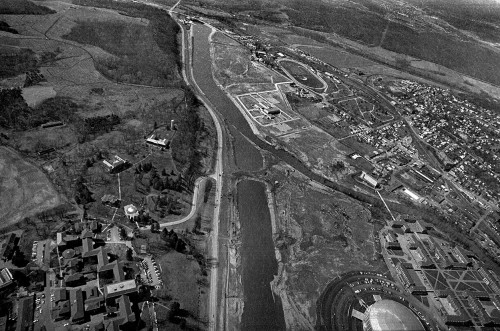 When I moved to Athens, Ohio, in 1967, I sneered at the puny Hocking River: “You call that a river? Where I come from, on the banks of the Mighty Mississippi River, we’d call that a creek at best.”
When I moved to Athens, Ohio, in 1967, I sneered at the puny Hocking River: “You call that a river? Where I come from, on the banks of the Mighty Mississippi River, we’d call that a creek at best.”
A year later, the Hocking would flood a significant part of the campus, prompting a major re-routing of the river. In this 1970 aerial, the old channel meandered through the heart of the low part of the campus. A dike or plug kept the old river from flowing down the new, straighter, wider channel during construction. (You can click on the photos to make them larger.)
Muskingum River bridge
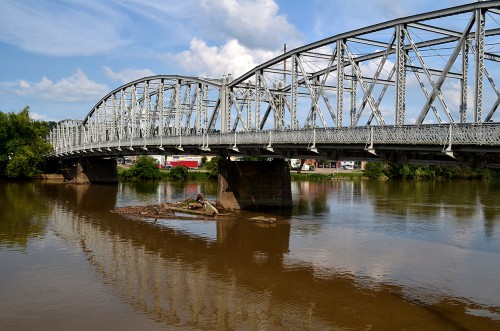 Malta was just down the road from Miners’ Memorial Park and Big Muskie’s bucket, so I paused to give Curator Jessica a chance to photograph this bridge over the Muskingum River because there was talk that it might be replaced. I left the motor running and stayed near the van.
Malta was just down the road from Miners’ Memorial Park and Big Muskie’s bucket, so I paused to give Curator Jessica a chance to photograph this bridge over the Muskingum River because there was talk that it might be replaced. I left the motor running and stayed near the van.
Twin City Saloon
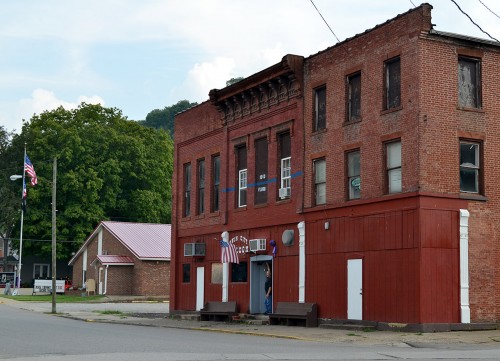 I was trying to make out what that blue line was on the red building when a guy came out, saw me and started pointing up at it. He walked over and struck up a conversation. He’s the owner of the Twin City Saloon, and that line represents how high the water got during the Flood of 1913.
I was trying to make out what that blue line was on the red building when a guy came out, saw me and started pointing up at it. He walked over and struck up a conversation. He’s the owner of the Twin City Saloon, and that line represents how high the water got during the Flood of 1913.
We chatted a bit, then I mentioned that Curator Jessica worked at the Athens museum and that we were lollygagging around the state visiting interesting places. When she walked back to where we were, he said, “I have something you need to see.”
Jessica gets kidnapped
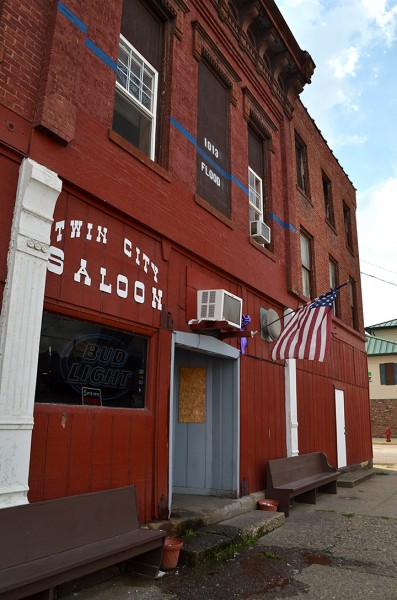 I didn’t want to leave the van unlocked and running, so I volunteered to move the van closer and lock it up. When I completed my task, I headed over to where I thought the couple had gone. No bar owner, no Jessica.
I didn’t want to leave the van unlocked and running, so I volunteered to move the van closer and lock it up. When I completed my task, I headed over to where I thought the couple had gone. No bar owner, no Jessica.
“That’s great,” I thought. “I’m going to have to go back to Athens to tell Hubby TJ that Wife Jessica has been sold down the Muskingum River for whatever curators are good for, and that it’s my fault for not keeping track of her.”
I decided to check the bar. It had a Closed sign up, but the door was unlocked. There was Jessica and the owner looking over some cool artifacts that had been in the building for more than 100 years.
The Great Flood of 1913
I can rattle off significant Mississippi River Floods: 1927, 1941, 1973, 1993, 2011, but I had never heard of the Great Flood of 1913. The History Channel said “It is estimated that the Great Flood of 1913 killed more than 1,000 Americans, making it the country’s second-deadliest deluge (behind only the 1889 Johnstown Flood, in which more than 2,200 lost their lives). The destruction cut across 14 states—reaching from Vermont to Michigan to Louisiana—making it the country’s most widespread natural disaster.
“The apocalyptic storm that caused the Great Flood of 1913 impacted more Americans than the San Francisco Earthquake and Fire of 1906, the Hurricane of 1938 and many other better-known natural disasters. So why has history largely forgotten it? Geoff Williams, author of a book on the Great Flood, said it’s because the impacted communities viewed the disaster as a local, rather than a national, calamity. ‘If you lived in Dayton, it was the Great Dayton Flood. If you lived in Indianapolis, it was the Great Indianapolis Flood. People thought of it in very local terms although it was a huge regional flood.‘”
Look at Marietta’s flood levels
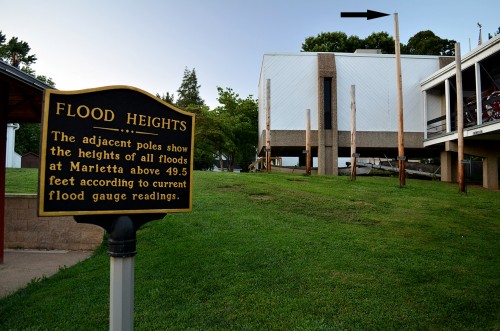 When we got down to Marietta, Ohio, there are some wooden poles that indicate the height of various Ohio River floods over the years. The tall pole at the right shows the March 1913 crest of 58.7 feet. The city’s website said that flood “The flood swept 120 homes away, knocked 200 homes off their foundations and water was eight feet deep in the old Post Office.”
When we got down to Marietta, Ohio, there are some wooden poles that indicate the height of various Ohio River floods over the years. The tall pole at the right shows the March 1913 crest of 58.7 feet. The city’s website said that flood “The flood swept 120 homes away, knocked 200 homes off their foundations and water was eight feet deep in the old Post Office.”
That’s pretty impressive.

Wow who knew about the great 1913 floods? Not me! Good work there Ken and Jessica.
Let me add the Flood of 1951 to your list. I was six years old at the time. That is the first and last flood I remember in the downtown area. I believe the flood wall was built around 1957.
I remember FW Woolworth’s, Penny’s and JJ Newberry stores with sandbags around them with pumps running. Across Main Street on the east side, Montgomery Ward’s had a board walkway into the store and up to the second and third floors. The first floor was completely flooded but business was as usual on the upper floors. The train depot was flooded. At the other end of Main Street, Buckner -Ragsdale’s basement was flooded but open for business on the Main Street level.
Dang, Bill Stone, I remember that flood too. I can smell the “aroma” from the flood right now. We walked down the wooden walkway to around Woolworth’s, I think.
I believe I came across information and flood stage locators for the great flood of 1913 at the Chilo Lock 34 Museum in Chilo Lock 34 Park in Clermont county Ohio. This free museum at this free park is very interesting and well worth the visit. They even have a photo of the sternwheeler named Cape Girardeau in that museum. I believe it was later renamed, but the photo they have clearly shows the name Cape Girardeau painted on the side of the steam boat.
There were at least three steamboats named the Cape Girardeau. A Missourian reader, Casey Mills, posted a photo of one of them with this background: The third Cape Girardeau (1924-1935) was a sidewheel packet constructed in 1924. It operated as the Eagle Packet Company’s commercial vessel from 1924 to 1935 between St. Louis, MO and Cape Girardeau, MO. Passengers praised the Cape Girardeau for being a spacious and luxurious boat. The boat made yearly trips to Mardi Gras in New Orleans, LA and the Kentucky Derby in Louisville, KY 1924. The Cape Girardeau’s name changed to Gordon C.Green when it was sold to the Green Line of Cincinnati, OH in 1935.”
Apparently, according to the current Google Maps aerial view, the Twin City Saloon in Malta was torn down sometime in the last couple years.
Sorry to hear that. I took these photos in 2014. Did it fall victim to another flood, gravity or urban renewal?